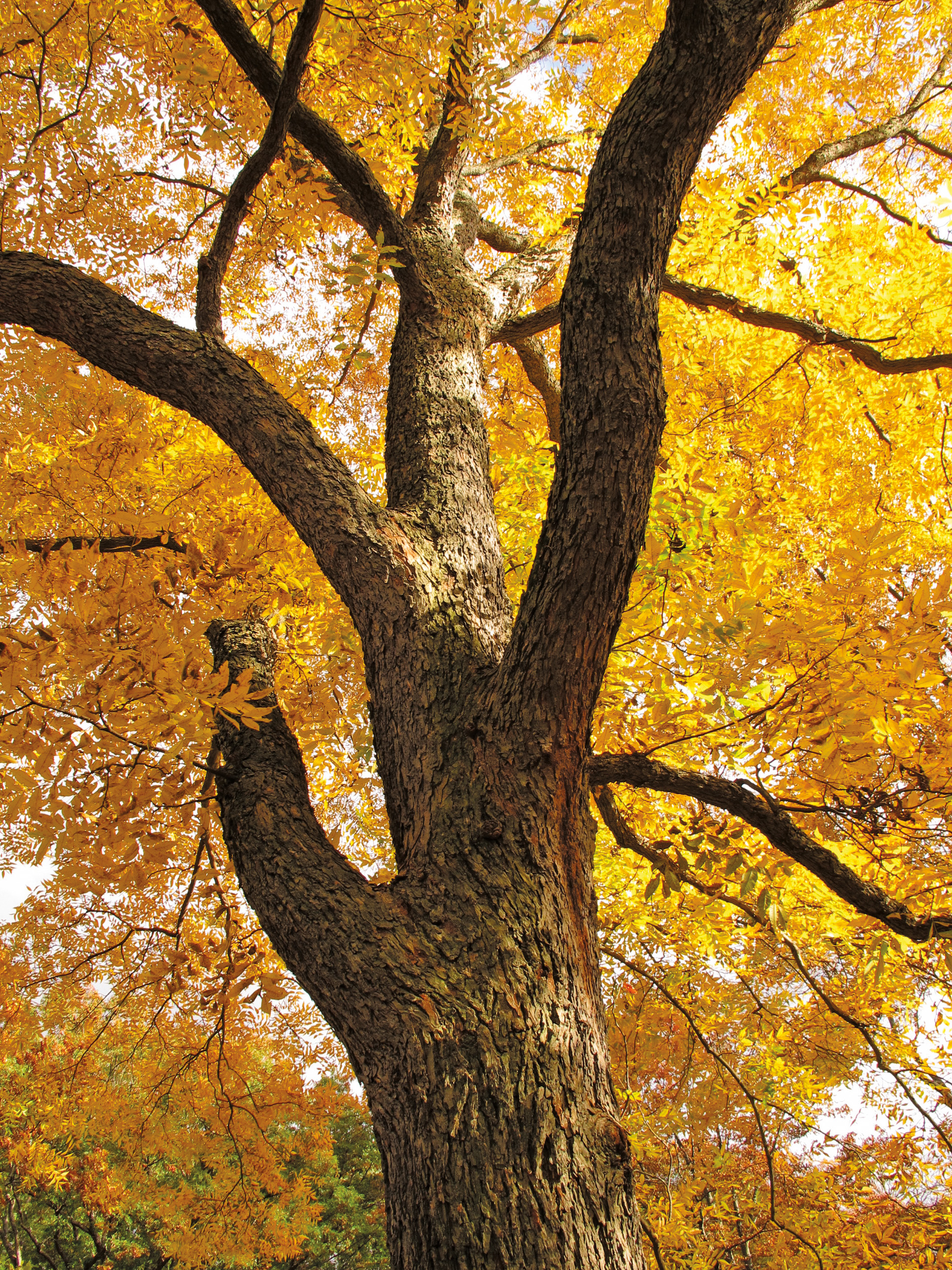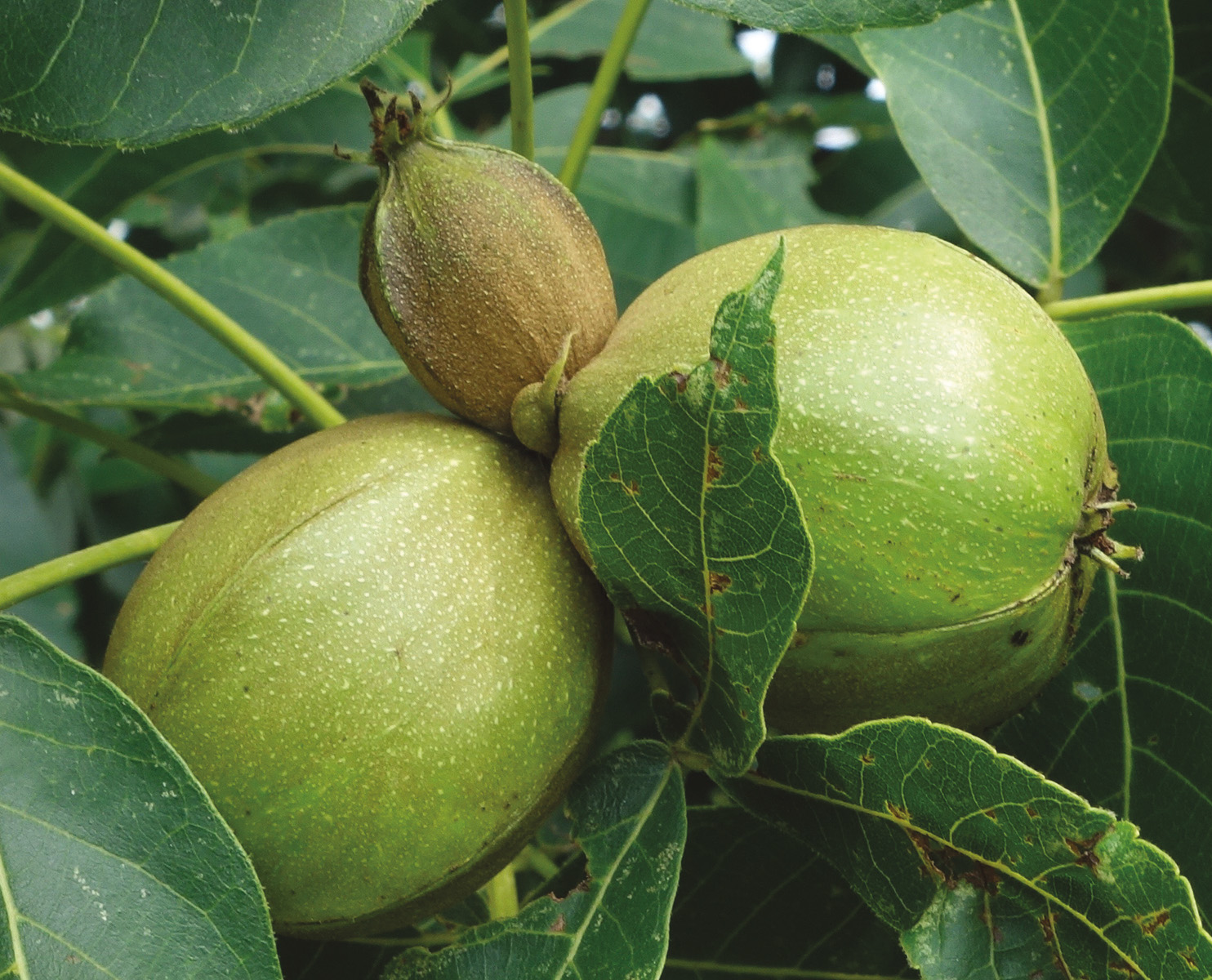
In a field behind my childhood home in Indiana, a huge shagbark hickory (Carya ovata) stands sentinel. As a little kid, I knew the tree marked the half-way point to the woods beyond the pasture—a route I often wandered (sometimes without permission). When I reached the tree, I would lean back, rest my head on the trunk, and look up, mesmerized by the coarse shags of bark and network of branches beyond. This tree grew to be a St. Joseph County champion and now measures 90 feet (26.8 m) tall and 31.5 inches (80 cm) in diameter. To this day when I visit my parents, I strike the same pose with my head against the trunk. The perspective never ceases to grip my imagination.
This tree instilled an early fondness for hickories, and the nursery rhyme line of “Hickory, Dickory Dock” probably helped me quickly learn its common name. The tree’s leaves showed up in multiple school projects including my herbarium collection in seventh grade. As I first spelled out C-A-R-Y-A on a label for that project, I could not have guessed that some thirty-five years later I would still be spelling the genus name in collection notes, in the same poor penmanship.
Carya includes nearly 20 species. Most are native to North America, including all of those alive in the Arboretum’s living collections. Although a handful of species occur in parts of eastern and southeastern Asia, their mostly frost-free origins mean they are not suited to Boston’s winters. Beyond the beloved shagbark, other common species include the shellbark (C. laciniosa), which at times has peeling bark rivaling that of the shagbark (often leading to misidentifications); the notably hairy mockernut (C. tomentosa); and the highly variable pignut (Carya glabra). In addition to these and other “true hickories,” the genus also comprises the “pecan hickories,” of which the pecan (C. illinoinensis) is most admired and the bitternut (C. cordiformis) the most northern and widespread.

The Arboretum’s connection to hickories and pecans goes back to the beginning of the institution. At one point, in those early years, the pace of collection reached a level that prompted Charles Sprague Sargent to refer to it as “hickory fever.” (Jonathan Damery’s 2018 Arnoldia article about this prolific history is a must read.) In our nearly 150 years, we have cultivated more than 500 hickories, starting with two shagbarks in 1873. Today, we grow nearly 175 in the permanent collections, and another 30-40 will move out from our nurseries in the next few years. We cultivate ten different species (plus a few hybrids), each with multiple accessions collected from different parts of their native ranges. (Almost 70 percent of our trees are of wild origin.) This yields one of the finest collections of its kind on Earth. Because of this, the Carya collection received National Accreditation in 2002, and is one of seven others (like Acer, Ginkgo, and Stewartia) at the Arboretum that are part of the Plant Collections Network.
The Arboretum’s first pecan accession arrived on April Fools Day 1881, sent from George Letterman in St. Louis, Missouri. It no longer survives, but the following year ornithologist Robert Ridgeway sent seed for a specimen that is now the Arboretum’s finest. Standing at more than 95 feet (29 meters) in height, accession 12913*A towers over many other trees in the hickory collection, not far from an enormous Persian ironwood (Parrotia persica) and a smattering of wingnuts (Pterocarya spp.). Despite being almost 140 years old, this pecan is perfectly healthy, a fact I attribute to provenance and over a century of care. Ridgeway made the collection near the Wabash River in Mount Carmel, Illinois, one of the northern-most populations within the species’ range. No doubt, a population that endured frigid midwestern winters would be content dealing with Boston’s.

Among our 18 accessioned pecans are some younger individuals collected on expedition. These include several that Jonathan Damery and I collected in 2013 near Horseshoe Lake in Southern Illinois, about 140 miles southwest of Ridgeway’s location. Tiffany Enzenbacher and Kia Woodruff made another collection in 2018 from Humnoke, Arkansas—about 400 miles to the south of Ridgeway’s collection. We have individuals from these recent acquisitions sited not only in the main hickory collection, just off the Centre Street Gate, but in an expanding collection of hickories on the southern edge of Peters Hill.
When you next visit the Arboretum, check in on these young trees as well as their bigger brethren. Or, if you are from farther afield and cannot make the trip, perchance you can find a hickory near you to admire, maybe even shuck a few nuts to sample (assuming the squirrels have not beat you to it). And, don’t forget to lean back and look up—you too will be captivated by the perspective.
From “free” to “friend”…
Established in 1911 as the Bulletin of Popular Information, Arnoldia has long been a definitive forum for conversations about temperate woody plants and their landscapes. In 2022, we rolled out a new vision for the magazine as a vigorous forum for tales of plant exploration, behind-the-scenes glimpses of botanical research, and deep dives into the history of gardens, landscapes, and science. The new Arnoldia includes poetry, visual art, and literary essays, following the human imagination wherever it entangles with trees.
It takes resources to gather and nurture these new voices, and we depend on the support of our member-subscribers to make it possible. But membership means more: by becoming a member of the Arnold Arboretum, you help to keep our collection vibrant and our research and educational mission active. Through the pages of Arnoldia, you can take part in the life of this free-to-all landscape whether you live next door or an ocean away.

